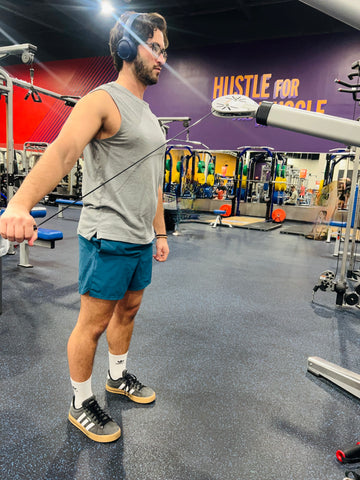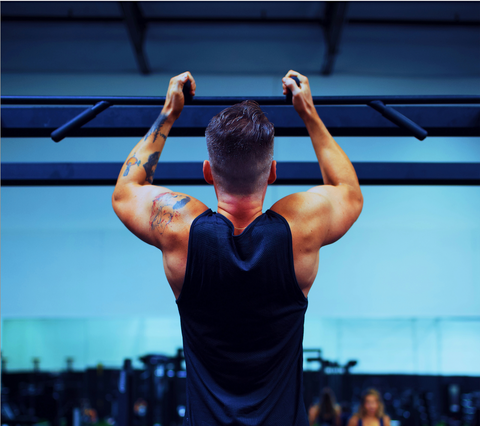The teres major and teres minor muscles are often ignored in many upper body routines. Despite their size, they are both very important for the stability and movement of the shoulder.
But before we get into teres major and minor exercises, let's dive into the functional differences between the two. Understanding their location and movement patterns will increase your ability to target each muscle more effectively.
Teres Major Anatomy and Function
The teres major can be found on the back of the shoulder beneath the teres minor. Sometimes referred to as the “sister muscle” to the latisimus dorsi, the teres major and latissimus dorsi share a close relationship. The muscles join at the back of the armpit, or lower shoulder blade, and attach to the front of the upper arm. They work together to bring the arm down, pull it toward the chest, and rotate the elbow inward. Along with the posterior deltoid, they also help extend the arm backward [1].

(teres major -> latissimus dorsi muscles and referred pain pattern)
Teres Minor Anatomy and Function
The teres minor is a small shoulder muscle that helps stabilize and rotate the arm outward. The teres minor is part of the rotator cuff and connects the back of the shoulder blade to the upper arm bone. This muscle's tightness can result in severe pain in the back of the shoulder, which frequently gets worse when sleeping on the affected side or doing specific activities. Overuse, such as frequently reaching up or back, may worsen existing pain. Treatment consists of self-massage, stretches, strengthening exercises, avoiding strain, and better posture [2].

Exercise #1 Face pulls (Teres Major and Minor)

Use a resistance band or cable machine rope for best results.
- Adjust the cable machine rope to head height.
- With your feet shoulder-width apart, face the machine, take a step back, and maintain a neutral hold on the rope.
- Stretch your arms out, lift your chest, contract your core, and draw the rope in the direction of your face until your hands are near your ears.
- Squeeze your shoulder blades, take a moment, and then slowly go back to the beginning. Repeat.
#2 Single Arm Dumbbell Row (Teres Major)
- Keeping a neutral spine and slightly staggered stance, place one hand on a bench or solid foundation for support.
- Hold a dumbbell in the opposite hand and extend your arm straight down.
- Allow your scapula to STRETCH before activating retraction.
- Squeeze your shoulder blade and engage the teres major by pulling the dumbbell up towards your hip while staying tight to your body.
- Slowly return and repeat.
- If you find yourself overcompensating by thrusting, decrease the weight.
- After completing the appropriate number of reps, switch arms.
#3 Band Pull Aparts (Teres Major and Minor)


- Choose your preferred resistance band.
- Place your feet shoulder-width apart.
- Raise the resistance band to a distance equal to shoulder width.
- Holding the resistance band, retract your shoulder blades while spreading your arms straight out in front of you.
- Bring both arms out to the sides while maintaining a firm core and a tall chest.
- Try to pull until the band until it hits your chest.
- Attempt to clench your shoulder blades together and briefly hold.
- Let the band gradually return to to the begining position.
- Repeat for as many reps as you want
#4 Side-lying External Rotation (Teres Minor)
Pro Tips:
- Put a towel in your armpit for further assistance and smoother rotation.
- Pull shoulder blades back and down throughout the movement.
- Slowly rotate upward while keeping elbow pinned to side.
- Start with a lighter weight and slow down or stop if you feel pain.
#5 Vertical Rotation Exercise (Teres Minor)
Pro Tips:
- Retract shoulder blades throughout movement
- Pull back instead of lifting up
- Start with a lighter weight
- Use this as a pre-workout warm up to bulletproof your shoulders
#6 Rear Cable Fly (Teres Major)

- Find a double cable machine in your gym.
- Attach handles (or no attachments at all) to each side of the machine - whatever is comfortable to grip.
- To isolate the teres major, adjust the cables to roughly head height.
- Face the machine, cross your arms, and grip the attachments, bringing them in front of your face.
- Retract your shoulder blades as you pull the weight across your body.
- Spread your arms out and downward to form a 45-degree angle with your body. Maintain a small bend in your elbows.
- Pause and return to your starting position and repeat.
#7 Reverse Dumbbell Fly (Teres Major)

- Grab 2 light-moderate weight dumbbells and stand shoulder width apart.
- Get in a bent over row stance - knees slightly bent and hips hinged at roughly 45 degrees.
- Instead of a rowing motion, lift your arms laterally, as if you’re doing the opposite motion of a chest fly.
- Focus on pinching your shoulder blades as you engage in lateral abduction.
- You should feel some tension in your upper back as you progress.
- Repeat for a desired number of reps.
#8 Pull-ups: Neutral Grip or Chin-Ups (Teres Major and Minor)
To target the teres major and minor keep a narrow or neutral grip. A narrow/neutral grip will promote greater engagement of the back muscles by keeping a more natural shoulder position. Standard wide grip pull-ups place a biggest stress on the lats.

#9 Supinated Lat Pulldown (Teres Major and Minor)

- Sit on the bench, reach up, and hold the bar. Grip the bar underhand and just outside shoulder width - (A narrow, supinated grip will better target the teres major)
- Lean back slightly and pull the bar to your upper ribs while maintaining your elbows tight and shoulder blades back.
- Pause at the bottom, squeeze, then slowly return to the start allowing your lats and teres major to stretch.
#10 Cable Pullover (Teres Major and Minor)


- Hinge slightly at the hips, arch your spine, and grip the attachment, feeling a lat and teres major stretch.
- With a slight bend in your elbows, squeeze your shoulder blades and brace your core.
- As you pull the weight to your waist, let your upper body rise slightly.
- Squeeze your lats at the bottom, hold briefly, then slowly return to the start.
- Focus on slow, controlled movements. Start with a lighter weight to protect your shoulders and avoid injury.
#11 Low Cable Row (Teres Major)

- Sit on the cable machine, feet on the footrests, knees slightly bent.
- Grip the attachment with your back straight, shoulders back, and chest out, slightly forward tilted.
- To activate the upper back and teres major, pull the weight slightly down and into your stomach.
- Keep your elbows in and pinch your shoulder blades.
- Avoid using momentum. Stop when the handle is close to your belly button, then proceed back to the starting position. Repeat.
FAQ:
What's the difference between the teres major and minor?
Although they are both found in the shoulder, the teres major and teres minor have differing roles and muscle bonds. The teres major is in close relation with the latissimus doris and helps in adduction, extension, and internal rotation of the humerus. The teres minor, on the other hand, is a relatively small muscle that stabilizes the shoulder joint. The teres minor is active in the rotator cuff group by helping the infraspinatus to externally rotate the humerus.
Can trigger points develop in the teres major?
Yes, trigger points in the teres major are not uncommon. These trigger points can cause intense discomfort in the posterior deltoid. Actions such as resting elbows on a table or desk or reaching up and forward to grab something from a shelf are indicators of teres major pain and trigger points [1].
Is it possible to tear your teres minor?
Yes, like any rotator cuff muscle, the teres minor is receptive to tearing. Symptoms may include weakness and pain in the shoulder or down the arm. Inability to externally rotate is another common side effect.
Does the rear delt machine target the teres major?
Yes, the rear delt machine is an awesome piece of equipment to activate the teres major, along with other upper back muscles such as posterior delts, rhomboids, and traps.
Sources:
[1] Davies, Clair, and Amber Davies. The Trigger Point Therapy Workbook: Your Self-Treatment Guide for Pain Relief. 3rd ed., New Harbinger Publications, Inc., 2013.
[2] Donnelly, Joseph M. Travell, Simons & Simons Myofascial Pain and Dysfunction: the Trigger Point Manual. 3rd ed., Wolters Kluwer Health, 2019.


